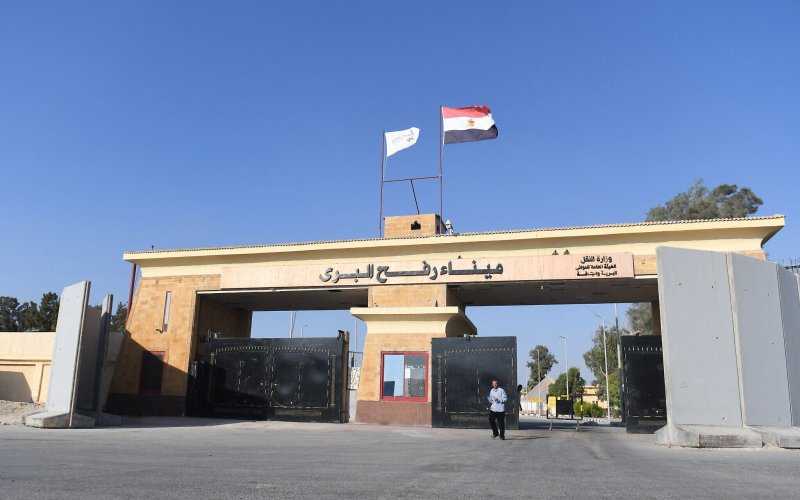Israel has announced the reopening of the Rafah border crossing with Egypt, a critical step aimed at easing the humanitarian crisis in the Gaza Strip, as tensions grow over the fragile ceasefire agreement with Hamas, News.az reports.
The decision comes amid disputes regarding the return of hostage remains and rising instability inside Gaza, raising questions about the durability of the current truce.
According to Israeli officials and Egyptian intermediaries, approximately 600 aid trucks carrying food, medical supplies, water, and reconstruction materials are expected to enter Gaza over the coming days. These deliveries will be subject to Israeli security inspections, as authorities continue to prioritize screening to prevent the smuggling of weapons or materials that could be used for military purposes.
The reopening of Rafah follows several days of intense negotiations involving Egypt, Qatar, and the United States, as well as pressure from international humanitarian organizations. The United Nations and aid agencies have welcomed Israel’s decision but emphasized that a single crossing is insufficient to meet the enormous needs of Gaza’s 2.3 million residents. Many have called for the opening of additional border points to accelerate aid flows and avoid logistical bottlenecks.
A major source of strain emerged after Hamas handed over four bodies to the International Committee of the Red Cross as part of the ceasefire’s phased exchange mechanism. DNA testing conducted by Israeli authorities confirmed that three of the bodies belonged to Israeli hostages, but the fourth did not match any known individual on Israel’s list of captives. This discrepancy has raised suspicions in Israel, with officials accusing Hamas of failing to fully comply with the terms of the deal.
In response, Israel temporarily threatened to restrict or delay aid deliveries through Rafah, linking humanitarian access to Hamas’s cooperation on the hostage issue. Israeli Prime Minister’s Office officials said that “aid will not flow freely while Hamas withholds information or fails to fulfill its obligations.” Hamas, however, denied any violations and claimed the error was due to the chaotic conditions on the ground.
Meanwhile, thousands of Palestinian civilians have begun returning to their neighborhoods, many of which lie in ruins after months of bombardment and ground fighting. Satellite imagery and field reports show widespread destruction of housing, hospitals, schools, power infrastructure, and water networks. With temperatures rising and services scarce, humanitarian conditions remain dire, despite the ceasefire.
The UN has warned that basic services such as electricity and water remain critically low, and that the flow of fuel for hospitals and generators is barely sufficient to sustain essential operations. Humanitarian convoys face additional challenges, including damaged roads and shortages of qualified local personnel to coordinate aid distribution.
Complicating the picture further are growing internal tensions between Hamas and local armed clans, particularly the powerful Doghmush clan. According to multiple reports, Hamas executed several individuals publicly, accusing them of collaborating with Israel. Clashes have erupted in parts of Gaza City and Khan Younis, highlighting a deepening law-and-order vacuum in some areas where Hamas’s authority is being challenged.
Observers warn that this intra-Palestinian power struggle could undermine ceasefire implementation and create additional obstacles for aid distribution and reconstruction efforts.
The latest developments come just days after a major peace summit in Sharm el-Sheikh, which brought together around 30 countries to support the Gaza ceasefire framework. Neither Israel nor Hamas participated directly, but the summit signaled international willingness to support a longer-term peace process. However, mediators acknowledge that without consistent adherence to the ceasefire terms and significant humanitarian progress, broader diplomatic efforts may falter.
As of October 16, the ceasefire remains in place but under significant strain. Key points of contention include the verification of hostage returns, the pace of humanitarian aid delivery, and the growing internal instability inside Gaza. Both Israel and Hamas accuse each other of failing to uphold their commitments, while civilians continue to bear the heaviest burden.
International mediators are expected to meet again in Cairo in the coming days to address the disputes and stabilize the truce, but the situation remains fluid and volatile. The Rafah crossing reopening, while significant, is only one element in a complex and fragile equation that will determine whether the ceasefire holds or collapses in the weeks ahead.
